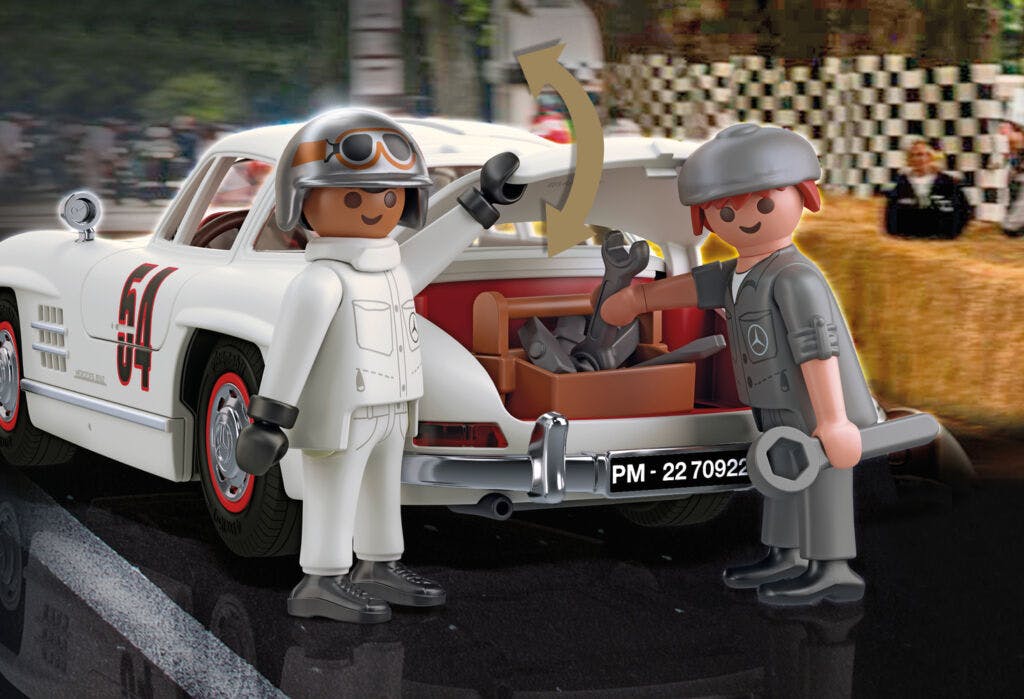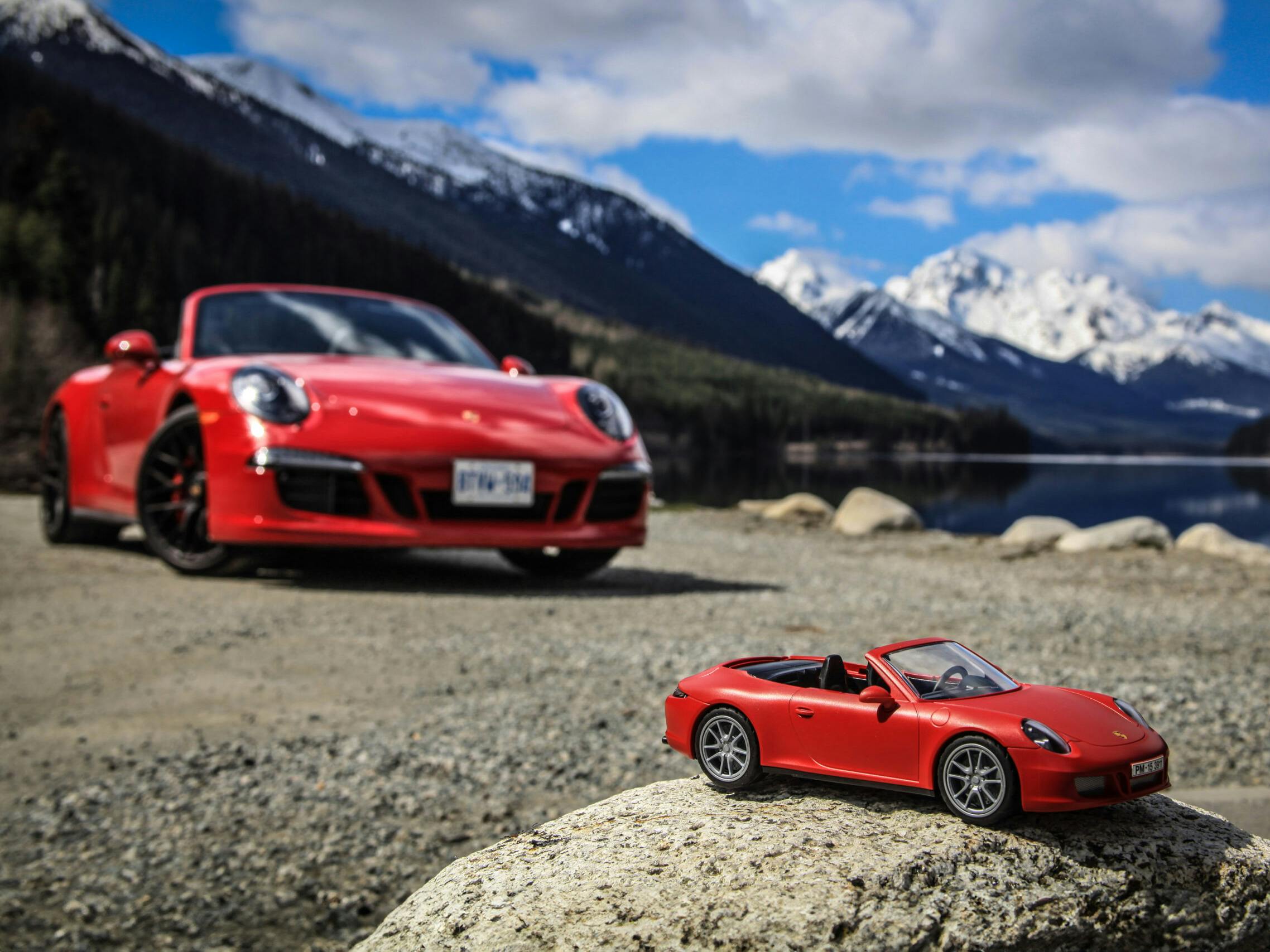Media | Articles
Playmobil’s New and Vintage Cars Are for Fans of All Ages
Usually, a lifetime of automotive enthusiasm doesn’t start with getting your driver’s license. Maybe you inherited it from handing your dad the socket wrench as he cursed under the family ride, maybe you picked it up from cheering your heart out at a day in the stands at the races, or maybe it was from the first time riding shotgun on a twisting backroad. But maybe it was a treasured childhood toy that lit that spark, rolling on kitchen linoleum rather than two-lane blacktop. In the case of Playmobil, currently celebrating its fiftieth anniversary, that spark is still there for the giving.
Hot Wheels, of course, has long been car culture’s go-to brand, and Lego is the world’s largest tire manufacturer. But leaving aside those two companies, there’s something particularly Germanic about Playmobil’s approach to building cars for young would-be enthusiasts.

If you haven’t been paying attention, the brand is on its A-game. Take, for instance, one of Playmobil’s latest sets, a Ferrari 308 GTS Quattrovalvole. Yes, that Ferrari 308, complete with a little mustachioed Magnum P.I. Playmobil figure. Not many kids today will remember the show, so perhaps this model is more aimed at collector fans of Magnum, but it is typically sturdily and sensibly constructed, ready for playtime. It even has working pop-up headlights.


Playmobil’s chief rival is probably Lego, to which it admittedly plays second fiddle. However, the scale and relative simplicity of Playmobil gives it a certain advantage when it comes to actual play. Lego’s big licensed models are designed to be built and then displayed, too fragile to go sailing into a sideboard or crashing down the stairs. Playmobil models are ready for rough-and-tumble use, which allows them to be used and cherished.
The company was founded in 1974 in Germany, and not unlike the Volkswagen Golf that debuted in that same year, the fuel crises of the 1970s were something of a boon. Playmobil’s parent company had a history stretching back to the nineteenth century, and built large plastic and metal toys like hula-hoops and beach buckets. Suddenly, as expensive oil meant expensive plastic, smaller, more complex toys would become more competitive.
Marketplace
Buy and sell classics with confidence
Happily, just such a play system was already in development, thanks to a company employee named Hans Beck who was a trained cabinet maker but a born toy maker. Beck, who is considered the “father of Playmobil,” first started out making toys for his younger siblings at the tender age of ten, carving cars and trucks and dolls. His personal hobby as an adult was building and flying model aircraft, a natural fit for someone clever with their hands.
When Beck went to work for Brandstätter Group, Playmobil’s parent company, he was originally going to develop model aircraft or cars. However, he was instead given the assignment to come up with play figures.

In period interviews, Beck mentions the German idea of Fingerspitzengefuhl, which literally translates to “fingertips feel.” It means a natural intuition and sensitivity, the delicacy to get the details right. German origins or not, you can get Fingerspitzengefuhl from the steering of a Lotus or the shifter action of a Honda S2000.
Beck’s insight was to simply do what he’d been doing since he was ten, and let kids guide the play. He developed a happy-looking scale-sized figure with simple moving arms and legs, and then watched how kids actually played with them. The first production figures were things like a knight and a sheriff, and there were soon accessories like horses and cars. Things were designed simply to be robust, but flexible enough for young imaginations. Fingerspitzengefuhl.


Playmobil’s earliest cars had little to do with actual cars besides having four wheels. A standard setup with a removable roof and two seats was sold between 1977 and 1993 (the Volvo 240 of toys?), with various stickers and color changes for it to portray everything from ambulances to rally cars. The racier versions have clip-on auxiliary lights and look vaguely like French hot hatchbacks.
However, it’s clear that at least one designer at Playmobil was a fan of Germany’s most famous sporting manufacturer, as a 1979 set simply called Racing Car is a remarkably faithful copy of a Porsche 917/30. Even so, it would take decades before Porsche and Playmobil came up with the obvious idea to collaborate.
Instead, it was BMW who was first to put in an order for a Playmobil based on an actual car, with a special promotional toy Z4 model. You could only get this model by going to select European BMW dealerships at the time the Z4 was launched, and arranging to test-drive a car. As a result, these are somewhat collectible today.


But the toy that opened the floodgates was a Playmobil Porsche 911 Carrera S that launched in 2015. At first, these were only available in Germany, and so I had a friend who was visiting the Porsche museum in Stuttgart pop one into their checked baggage as a birthday present for my kid. It was a big hit, especially along with a ride in a matching convertible 911 GTS.
Currently, Playmobil’s lineup includes several sets aimed at those nostalgic for the 1980s, with the Magnum P.I. Ferrari joined by the GMC van from The A-Team, and of course the Back To The Future DeLorean DMC-12. But if you’re hoping to spur a little classic car interest in your kids or grandkids, there is also a lineup of classic icons: a Volkswagen Beetle, VW Bus, Mercedes-Benz 300SL Gullwing with period racing accessories, a 911 2.7RS, and groovy 1960s Mini Cooper. Not yet available in North America is an endlessly charming scale model of the Citroën 2CV. Or you can go modern with a Ferrari SF90, which comes complete with figurines and tiny golf clubs (because of course it does).



All feature a level of surprising detail that might put you in the mindset of the way cars in classic European graphic novels like the Tintin series were painstakingly accurate. They look like the real thing, and are perfect for exploring the backyard or other pint-sized adventures.
And who knows: perhaps a tiny VW Beetle will be the start of a lifetime’s passion. Here’s hoping Playmobil keeps adding new classics to its lineup, keeping enthusiasm going for a new generation.























TOYS? I clicked on this for toys?!
Okay, Burgermeister Meisterburger.
I liked the image of the Herr Doktor Ingenieurs having a laugh.
I will be checking their webpage for a C4 Corvette. Have fun with cars!
I can afford the toys, not so sure on the real thing.
Built 1/ 25th scale models of most the mussel cars I owned, all 12 of them including the one special 83 Z28 modified in Elkhart In. into a 2 seat version with a 350 cross fire fuel injection. Remember they did not build a corvette in 83 they were down for retooling. It was good to turn 16 in 1964 right in the lunch of the mussel car era. Still have one real Mustang full size go act like I’m 16 again.
Playmobil’s motorcycles were based on BMW twins for years. I have a 1983 dated police motorcycle that is recognizably an Airhead and one from the oughts that’s clearly an oilhead. They also had a circa 2004 car that was clearly an E46 3 series convertible.
Here in Canada, I already have the Playmobil Citroën 2CV, thanks to my son’s outstanding “Google-Fu”. The model is even in a shade of blue almost identical to my own real car. Heaven! The only very minor let down was that in the pre-release PR material, the model had rectangular headlights (a 3 year only variation in real life) whereas the production version has round headlights. A minor quibble. Vive la différence!
I use my 1:43 Diecast clsssic European model cars in my Christmas Village every year. Would be happy to share photos.
Yep, my 2CV model matches my real one!
I’ve got their blue Targa. Matching my ’18 Targa 4.